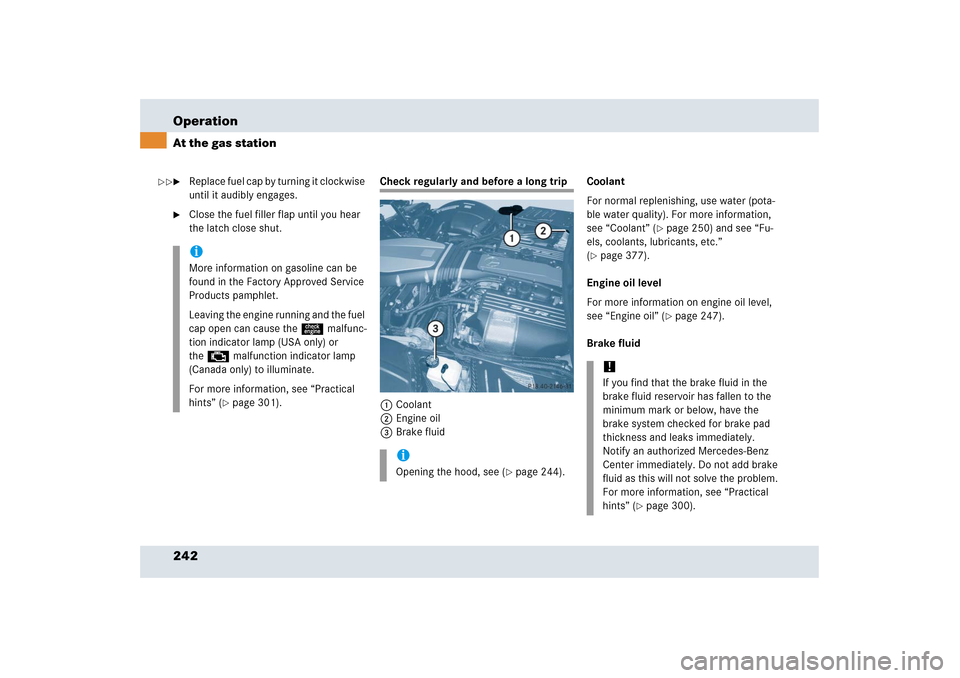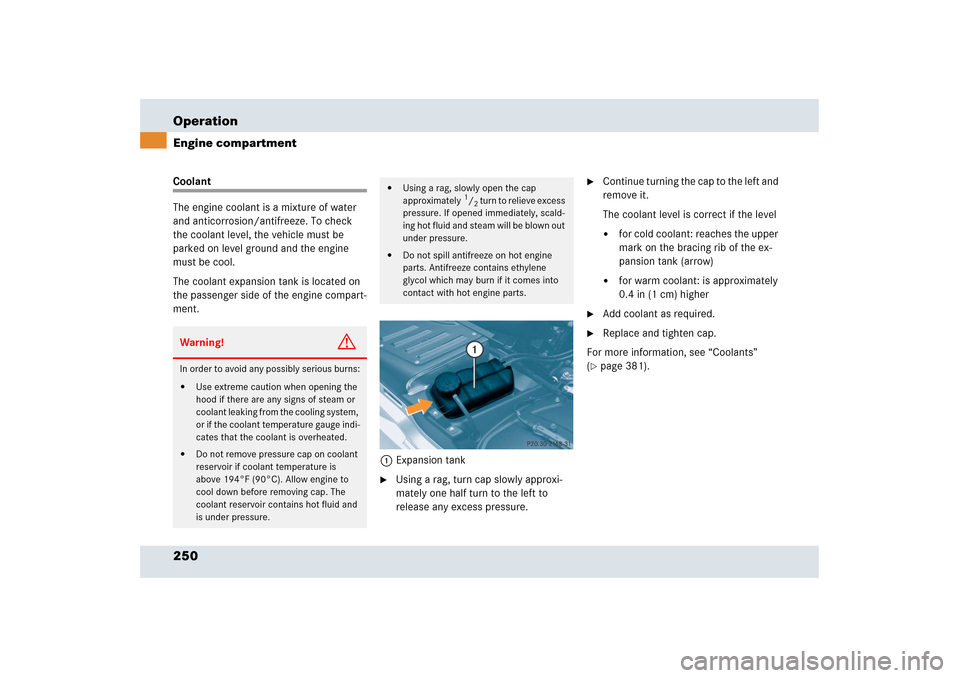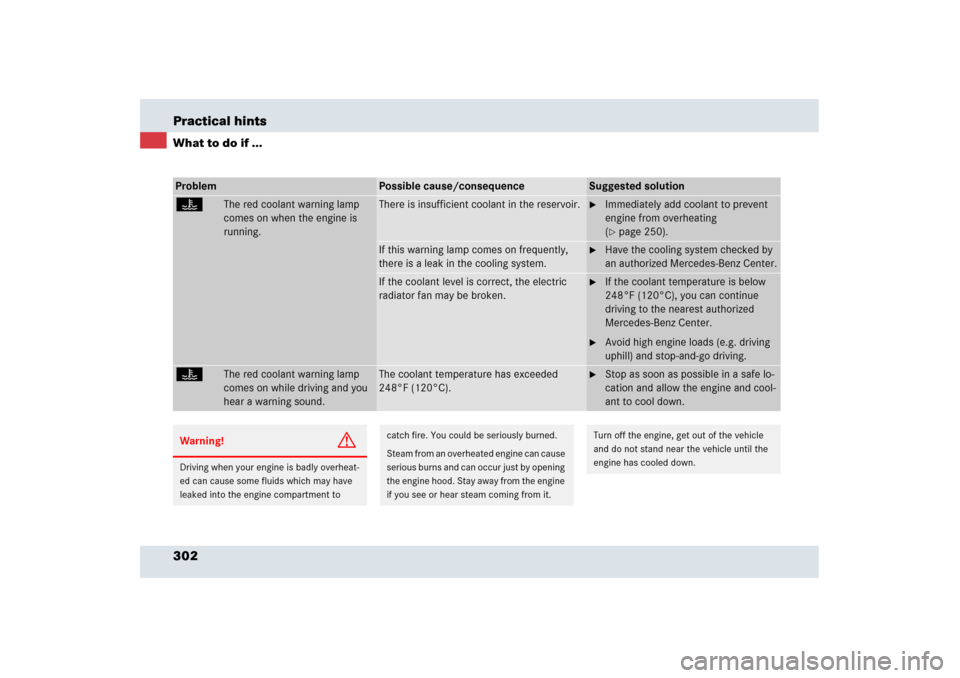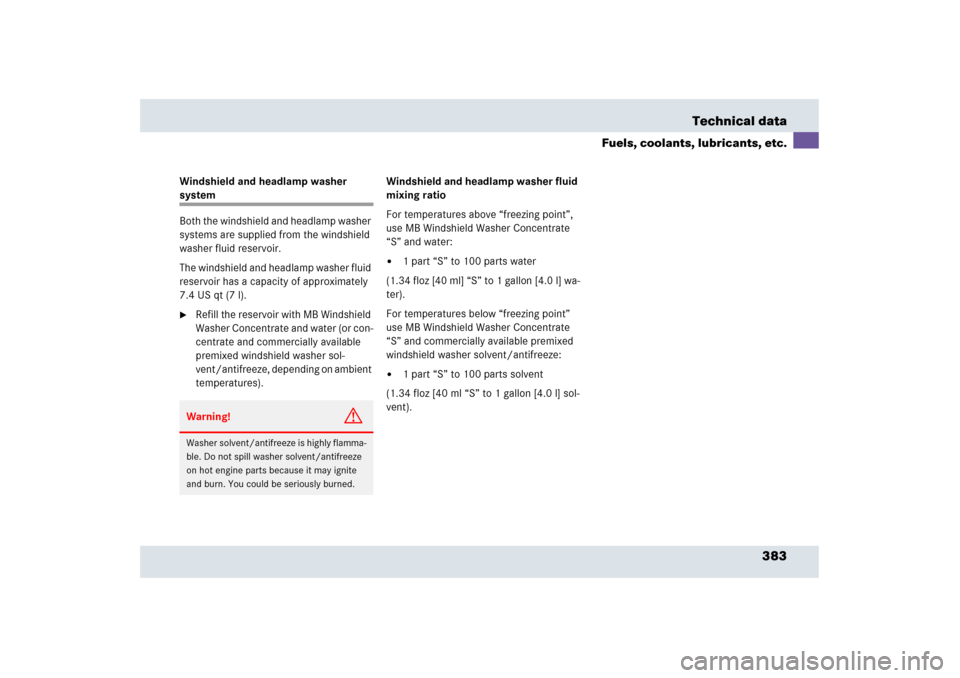Page 243 of 409

242 OperationAt the gas station�
Replace fuel cap by turning it clockwise
until it audibly engages.
�
Close the fuel filler flap until you hear
the latch close shut.
Check regularly and before a long trip
1Coolant
2Engine oil
3Brake fluidCoolant
For normal replenishing, use water (pota-
ble water quality). For more information,
see “Coolant” (
�page 250) and see “Fu-
els, coolants, lubricants, etc.”
(
�page 377).
Engine oil level
For more information on engine oil level,
see “Engine oil” (
�page 247).
Brake fluid
iMore information on gasoline can be
found in the Factory Approved Service
Products pamphlet.
Leaving the engine running and the fuel
cap open can cause theú malfunc-
tion indicator lamp (USA only) or
the± malfunction indicator lamp
(Canada only) to illuminate.
For more information, see “Practical
hints” (
�page 301).
iOpening the hood, see (
�page 244).
!If you find that the brake fluid in the
brake fluid reservoir has fallen to the
minimum mark or below, have the
brake system checked for brake pad
thickness and leaks immediately.
Notify an authorized Mercedes-Benz
Center immediately. Do not add brake
fluid as this will not solve the problem.
For more information, see “Practical
hints” (
�page 300).
��
Page 251 of 409

250 OperationEngine compartmentCoolant
The engine coolant is a mixture of water
and anticorrosion/antifreeze. To check
the coolant level, the vehicle must be
parked on level ground and the engine
must be cool.
The coolant expansion tank is located on
the passenger side of the engine compart-
ment.
1Expansion tank
�
Using a rag, turn cap slowly approxi-
mately one half turn to the left to
release any excess pressure.
�
Continue turning the cap to the left and
remove it.
The coolant level is correct if the level �
for cold coolant: reaches the upper
mark on the bracing rib of the ex-
pansion tank (arrow)
�
for warm coolant: is approximately
0.4 in (1 cm) higher
�
Add coolant as required.
�
Replace and tighten cap.
For more information, see “Coolants”
(
�page 381).
Warning!
G
In order to avoid any possibly serious burns:�
Use extreme caution when opening the
hood if there are any signs of steam or
coolant leaking from the cooling system,
or if the coolant temperature gauge indi-
cates that the coolant is overheated.
�
Do not remove pressure cap on coolant
reservoir if coolant temperature is
above 194°F (90°C). Allow engine to
cool down before removing cap. The
coolant reservoir contains hot fluid and
is under pressure.
�
Using a rag, slowly open the cap
approximately
1/2 turn to relieve excess
pressure. If opened immediately, scald-
ing hot fluid and steam will be blown out
under pressure.
�
Do not spill antifreeze on hot engine
parts. Antifreeze contains ethylene
glycol which may burn if it comes into
contact with hot engine parts.
Page 303 of 409

302 Practical hintsWhat to do if ...Problem
Possible cause/consequence
Suggested solution
D
The red coolant warning lamp
comes on when the engine is
running.
There is insufficient coolant in the reservoir.
�
Immediately add coolant to prevent
engine from overheating
(�page 250).
If this warning lamp comes on frequently,
there is a leak in the cooling system.
�
Have the cooling system checked by
an authorized Mercedes-Benz Center.
If the coolant level is correct, the electric
radiator fan may be broken.
�
If the coolant temperature is below
248°F (120°C), you can continue
driving to the nearest authorized
Mercedes-Benz Center.
�
Avoid high engine loads (e.g. driving
uphill) and stop-and-go driving.
D
The red coolant warning lamp
comes on while driving and you
hear a warning sound.
The coolant temperature has exceeded
248°F (120°C).
�
Stop as soon as possible in a safe lo-
cation and allow the engine and cool-
ant to cool down.
Warning!
G
Driving when your engine is badly overheat-
ed can cause some fluids which may have
leaked into the engine compartment to
catch fire. You could be seriously burned.
Steam from an overheated engine can cause
serious burns and can occur just by opening
the engine hood. Stay away from the engine
if you see or hear steam coming from it.
Turn off the engine, get out of the vehicle
and do not stand near the vehicle until the
engine has cooled down.
Page 384 of 409

383 Technical data
Fuels, coolants, lubricants, etc.
Windshield and headlamp washer system
Both the windshield and headlamp washer
systems are supplied from the windshield
washer fluid reservoir.
The windshield and headlamp washer fluid
reservoir has a capacity of approximately
7.4 US qt (7 l).�
Refill the reservoir with MB Windshield
Washer Concentrate and water (or con-
centrate and commercially available
premixed windshield washer sol-
vent/antifreeze, depending on ambient
temperatures).Windshield and headlamp washer fluid
mixing ratio
For temperatures above “freezing point”,
use MB Windshield Washer Concentrate
“S” and water:
�
1 part “S” to 100 parts water
(1.34 floz [40 ml] “S” to 1 gallon [4.0 l] wa-
ter).
For temperatures below “freezing point”
use MB Windshield Washer Concentrate
“S” and commercially available premixed
windshield washer solvent/antifreeze:
�
1 part “S” to 100 parts solvent
(1.34 floz [40 ml “S” to 1 gallon [4.0 l] sol-
vent).
Warning!
G
Washer solvent/antifreeze is highly flamma-
ble. Do not spill washer solvent/antifreeze
on hot engine parts because it may ignite
and burn. You could be seriously burned.